► The numbers behind the 2023 F1 season
► Have the new regulations failed?
► What to expect from 2024 and beyond
Have you been turned off Formula 1 by the ‘Max Factor’? If so, it’s understandable. Red Bull’s flying Dutchman Max Verstappen set a raft of new records in 2023 on his way to a third consecutive world title. There’s the mark of most wins in a season (19 out of 22 races), most consecutive wins (10) and a mammoth points haul (575) that would have won his Red Bull-Honda squad the constructors’ title even without team-mate Sergio Pérez’s contribution (285). That’s a gargantuan 860 points in total versus 409 for best-of-the-rest Mercedes. Red Bull was untouchable, almost going unbeaten, only for an off-weekend in Singapore to leave a lone crumb for Carlos Sainz Jr and Ferrari.
But the stat that really tells the story of the year for me is laps led in grands prix. Verstappen managed 1003 across the 22 races. Perez was next on the list – on just 146. Still just 26, Verstappen had F1 by the throat in 2023 – and throttled the life out of it when it came to wondering who was going to win each weekend.
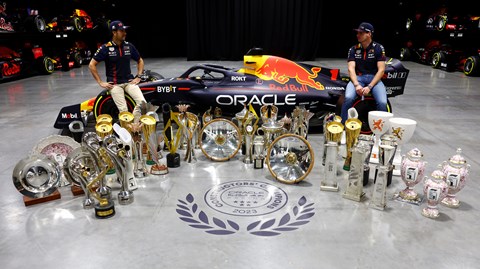
The near-whitewash raises awkward questions. F1 introduced a new generation of racing car in 2022 specifically designed to improve the racing spectacle. An emphasis on under-side ground-effect aerodynamics and prescriptive rules on the shapes and contours of wings and bodywork on the surface was supposed to slash the ‘dirty air’ effect – the turbulent wake that for years has limited how closely F1 cars can run nose to tail. Overtaking is now supposed to be easier. But judging by those Red Bull and Verstappen stats, the regs haven’t worked – have they?
It’s not that simple. Nothing ever is in the complex, nuanced world of F1. Actually, the overall picture when you include the far less predictable state of form behind Verstappen suggests the new rules have worked. Actually, we can go further: data tells us the racing has got better since the last year of the previous regulations in 2021.
CAR headed direct to the source and spoke to the man behind the regulations, F1’s chief technical officer Pat Symonds. He offered us a snapshot analysis from the figures he and his small team of engineers use after every grand prix to measure how well (or otherwise) they have done their job. Make no mistake, F1 takes this subject seriously.
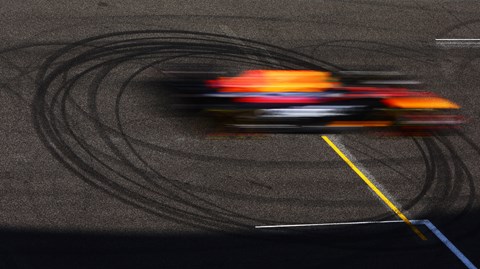
They measure three key indicators, from data collected every 200 metres around every circuit: how many changes of position take place in a race; a mean gap in seconds of how closely cars run to each other; and from those numbers a more complex set, but one that is directly useful for computing team strategy – the probability of overtaking. This is worked out in seconds across two scenarios: how much faster does a following car have to be to have a 90% chance of overtaking, or a 40% chance? The lower that number, the better the regulators have succeeded in creating closer racing.
Symonds picked two circuits at random, Abu Dhabi’s Yas Marina and Silverstone, and compared the figures from 2021 to 2022 and 2023 running to the new regulations. As usual with statistics, Symonds takes care on drawing conclusions. Weather conditions on a given day, tyre wear and specific aspects of a team’s performance might skew the numbers. For example, Silverstone’s data suggests the quality of racing declined from 2022 to 2023 – even if the probability of overtaking actually went up – although both sets of figures are better than in 2021. That final point is the main draw for Symonds.
‘What I conclude is that between 2021 and 2022 we made a significant difference to the ability of a car to follow closely and hence to overtake,’ he says. ‘That’s reflected anecdotally in what the drivers were saying too. In 2023 it was not quite as good as ’22. In Abu Dhabi, yes, we got more overtakes last year, but the probability says it was a little bit harder. Overall, the field is closer – less than 2022, but still miles better than ’21.’
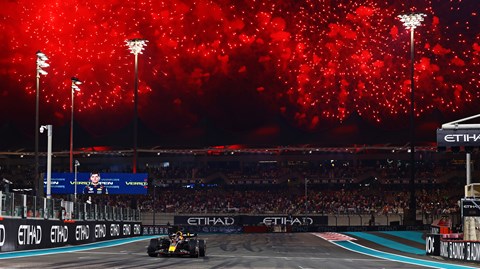
CAR puts it to Symonds that increasing familiarity with the new regulations and the teams’ natural inclination to fight against the rule makers’ intentions have weakened the closer-racing case. ‘Up to a point,’ he concedes. But before we get into that, Symonds is keen to point out something no regulator can combat: that infernal ‘Max Factor’ that has made the ultimate results so predictable. It sure didn’t feel ‘better’.
‘What made it more difficult in 2023 was Verstappen,’ he states. ‘If you took him away there was some fabulous racing going on.’
Symonds is the archetypal poacher-turned-gamekeeper, having engineered Michael Schumacher to his twin world titles with Benetton in 1994-95 and was technical director for Fernando Alonso’s back-to-back successes with the same team in its Renault guise in 2005-06. ‘Red Bull have done a fabulous job, their car is wonderful,’ he says. ‘But it’s a bit like what I had with Michael at Benetton in 1994, where the car and the driver are just completely at one. If Pérez had been the lead driver at Red Bull last year the championship and the racing would have been totally different, wouldn’t it? It’s not just that they’ve built a really good car, they have produced one Verstappen is totally confident in. That makes him a hard act to follow.’

What Symonds won’t say – but we will! – is that it doesn’t help how Red Bull’s main rivals, namely Mercedes and Ferrari, have missed the sweet spot by so much, in stark contrast to Adrian Newey and his team. You could argue it’s the failing of rivals rather than regulators that has allowed Verstappen to squeeze the life out of F1.
Factor in that for the first time ever an identical grid of the same drivers in the same cars that finished the previous season will line up when the new campaign starts (in Bahrain on March 2) – and it’s currently a tough sell. More of the same is the fear.
So is the ‘Max Factor’ having a clear and definite impact? F1 is highly sensitive to any suggestion the boom in interest fired by the so-called ‘Netflix effect’ and the streaming giant’s ‘Drive to Survive’ TV series is beginning to wane. Nevertheless, in 2023 F1’s social media engagement saw a decline for the first time since 2018. Analysis by Buzz Radar reported that F1 mentions declined by 70.7 per cent, new followers fell by 49.2 per cent and ‘social reach’ dropped 64.1 per cent.
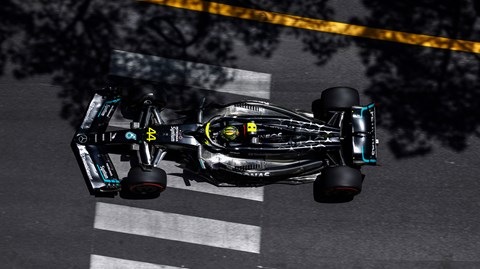
TV figures are closely guarded, but US network ESPN did report a mixed set last year. It said last season was the second most-watched F1 season in terms of US TV with an average viewership of 1.11 million over the 22 races. But the most-watched season was 2022, at an average of 1.21 million – so that’s a small drop. Still, given that in 2018 the average viewership was 554,000 the trend is impressive growth.
Consider also live crowds at the tracks. Average attendance has hit a remarkable 300,000, compared to a pre-pandemic number of 198,330 in 2019. Three races last year achieved attendance of more than 400,000: the British Grand Prix (480,000), Australian GP (444,631) and Austin’s US GP (432,000). Selling tickets is not a problem.
Still… F1 is ‘boring’. Isn’t it? ‘It’s definitely not boring from my perspective,’ said Lewis Hamilton ahead of the Miami GP last year. ‘But as a racing fan, I can understand [the boredom factor] because there’s not as much competition as they’re used to.
‘We need to do better as a sport. They have already tried to bring the teams closer, but it never seems to work. All I can say is that we’re working as hard as we can to close up and get back to that… and give them some more excitement.’
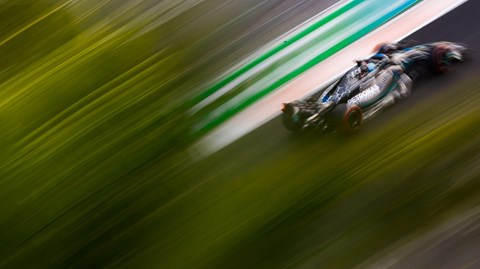
Clearly, it’s far from ideal that Verstappen has made F1 so predictable. No one wants to see one-drive domination. But Symonds is right: set aside the ‘Max Factor’ and there’s nothing predictable about F1 at all. Mercedes, Ferrari, Aston Martin and McLaren all experienced wide swings in form through 2023, often race to race. Yes, it was always to be best of the rest, Singapore aside. But boring? No, it wasn’t.
Today, F1 is more competitive than it has ever been, in terms of the gap from the back of the field to the front. A glance at qualifying tells you that. In 2023, all 10 teams made it at one point or another into Q3, the final shoot-out session to decide the grid – and the mean gap from pole position to 10th across the season, in Q3 sessions run in the dry, was just over a second. Compare that to 1988, when Ayrton Senna and Alain Prost carved up 15 of the 16 races between them for McLaren. Back then, the average gap from pole to 10thon the grid, set across two sessions run on separate days, was 3.14sec. At the final race of that season, in Adelaide, Senna’s pole time was a massive 1.7sec faster than the closest non-McLaren (Nigel Mansell’s Ferrari). Such gaps are inconceivable today, unless it rains.
‘Also we regularly saw seven different makes of car in the top 10 results of races last year,’ Symonds points out. That’s true: it happened 10 times out of 22, and at the US GP there were eight crammed in. ‘It must be terribly frustrating if you are in the midfield,’ says Symonds. ‘You can go from hero to zero in three-tenths of a second.’

Remember too that one-driver domination is hardly a novelty in F1. Those five consecutive world titles for Schumacher and Ferrari between 2000-04; four for Sebastian Vettel and Red Bull between 2010-13; a numbing eight for Mercedes between 2014-21, with six drivers’ crowns for Lewis Hamilton and one for Nico Rosberg in 2016.
The problem is we’re living in the wake of the intense Verstappen vs Hamilton storyline of 2021, complete with controversial Abu Dhabi ending, which was very much an anomaly. Two equally matched drivers in two equally matched rival teams – the ideal sporting scenario. Perhaps the closeness of that fantastic duel has made Verstappen’s subsequent domination across the past two seasons harder to swallow.

But what’s next? Will the pack close up on Verstappen and Red Bull, or will teams prevail in designing around the regulations, to the detriment of the show? Impossible to say for 2024 – but Symonds is at least optimistic the next set of rules he and his team are currently finalising for 2026 will tighten the game once more.
‘If you want a good set of regulations, what you want is the same objective for regulator and competitor,’ he explains. ‘[With the old rules] in 2021, in order to make gains you needed a lot of aerodynamic ‘outwash’ because what kills performance in particular is front wheel wake. So you try to push those wakes away from the car [creating so-called ‘dirty air’], which is why it becomes difficult for another car to follow. What we tried to do with these current rules was keep that wake close to the car, keep it inboard but lift it up and over the following car. But that meant what we wanted to do and what the teams wanted to do was different… They want outwash [to stop another car following closely], we want ‘inwash’ – and they will do everything they can to get their outwash back.
‘For 2026, if we want inwash to aid the following car’s performance we need to design a car where the inwash also gives the lead car performance too. Then you won’t have people spending all their time trying to destroy your good work! That’s essentially what we are looking at in 2026, and why I’m firmly of the opinion that the next generation of car will be even better at following than this one.’
The trouble is, there are still two seasons to run before we get to 2026. F1 fans tend to be loyal – but you’d be surprised if executives within Liberty Media didn’t have the odd worry line or two. If Verstappen keeps winning, will their precious bubble burst?